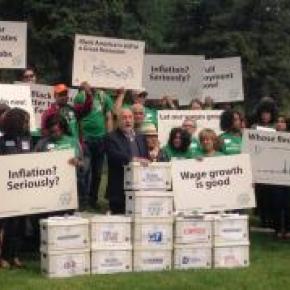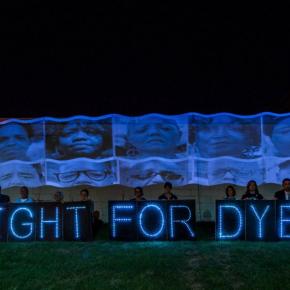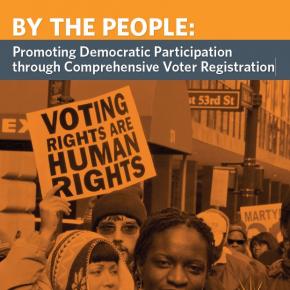More Cities Should Do What States and Federal Government Aren't on Minimum Wage
More Cities Should Do What States and Federal Government Aren't on Minimum Wage
Source:...
Source: Gotham Gazette
Early this month, New York City Mayor Bill de Blasio announced a guaranteed $15 minimum wage for all city government employees by the end of 2018. This is a big win for over 50,000 workers across the city struggling to provide for their families, including those directly on the payroll and tens of thousands working at non-profits that contract with the city.
Unlike in Seattle and Los Angeles, where city officials are empowered to raise the minimum wage for the entire workforce in their cities, Mayor de Blasio is unable to unilaterally raise wages for all New York City workers. That power lies with Gov. Andrew Cuomo and the state legislature. The governor's efforts to lift the minimum wage to $15 are being hampered by a Republican-controlled state Senate.
De Blasio's decision to raise wages for city employees is a crucial independent step towards a more equitable city - and should be seen as an inspiration for cities around the nation. It also reflects the power and momentum of a groundbreaking worker-led countrywide movement demanding higher wages.
Even as state and federal administrations drag their feet on the inevitable question of a decent minimum wage for working families in the United States, de Blasio's gutsy move shows cities can and should take matters into their own hands.
The mayor's minimum wage raise closely follows his announcement last month giving six weeks paid parental leave, and up to 12 weeks when combined with existing leave, to the city's 20,000 non-unionized employees. The mayor has now moved to negotiate the same benefits with municipal unions. Again, New York City private sector workers must look to Albany or Washington, D.C. to move on paid family leave for all.
Mayor de Blasio's recent actions support his goal of lifting 800,000 New Yorkers out of poverty over ten years. More than 20 percent of the city's population lives in poverty, a huge swath of a city commonly associated with extraordinary wealth.
The last couple of years have seen unparalleled momentum from workers themselves - from New York City to Los Angeles and Chicago - calling for livable wages, resulting in minimum wage raises for fast food workers and other groups.
Workers are not waiting patiently on government officials – they are organizing in an unprecedented way. Progressive mayors like de Blasio are responding with sound policy, while less responsive officials are being put on notice. Cities like Los Angeles, New York City, and Chicago are paving the way, showing that it is possible to act independently of state and federal governments.
In addition, laws raising the minimum wage to more than the pitiful federal standard of $7.25 an hour have passed in a number of states. There are now campaigns to raise the floor and standards for workers being led in 14 states and four cities. This momentum is building into a crescendo that will have deep implications for the 2016 presidential election.
Nearly half of our country's workers earn less than $15 an hour and 43 million are forced to work or place their jobs at risk when sick or faced with a critical care-giving need. Now is the time for cities to listen to their workers and override state and federal passivity to allow millions of hard-working Americans to provide for their families.
Representación legal gratis
Telemundo – July 21, 2013 - Indocumentados en NYC podrán contar con un abogado sin pagar honorarios. ...
Telemundo – July 21, 2013 - Indocumentados en NYC podrán contar con un abogado sin pagar honorarios.
Source
D-FW activists travel to annual Fed summit in Jackson Hole, Wyo., to spread their message
Lemlem Berhe is one of a handful of activists from the Dallas-Fort Worth area visiting Jackson Hole, Wyo., in hopes of...
Lemlem Berhe is one of a handful of activists from the Dallas-Fort Worth area visiting Jackson Hole, Wyo., in hopes of getting their message heard. That message: Raising interest rates now would stunt wage growth and hurt working families and communities of color.
“Fed officials think the economy has recovered enough to raise interest rates, slowing down job and business growth, but working families like mine in Dallas know otherwise,” Berhe said. “That’s why we’re in Wyoming this week, to ask them to prioritize job growth and higher wages.”
As part of the national FedUp Coalition, local members of the Texas Organizing Project and the Workers Defense Project are in Wyoming for the Federal Reserve’s annual summit, where the world’s most powerful central bankers discuss economic policies that affect people everywhere. The top U.S. banker — Fed chairwoman Janet Yellen — is not attending the event, which began Thursday and ends Sunday.
This is the first time anyone from either group has traveled to the Fed’s annual summit in Jackson Hole.
This year’s Jackson Hole Economic Policy Symposium comes as the Fed faces a difficult decision on when to start raising interest rates, rising debates on income inequality and wages, and worries about slowing Asian economies, most notably in China.
With the U.S. unemployment rate at 5.3 percent in July, some say it’s time to raise interest rates, which have been near zero for nearly seven years. Recently, some economists and one Fed banker have called for a delay given concerns about slower global economies.
On Friday, the organizing groups in Jackson Hole held a public demonstration and teach-ins on topics such as full employment and the selection process for regional bank presidents, with renowned Columbia University economist Joseph Stiglitz. Today, he wrote an op-ed column in the Los Angeles Times about why the Fed should not raise interest rates.
In addition, the Texas Organizing Project also made a second request in a video posted to its Facebook page and in a tweet to meet with Robert Steven Kaplan, the newly named president of the Federal Reserve Bank of Dallas, soon after he starts his new job on Sept. 8. Kaplan is attending the summit.
Kaplan will replace Richard Fisher, who retired in March after a decade leading the Dallas Fed. Last week, immediately after the regional bank named Kaplan, the Texas Organizing Project suggested he meet with some of its members in Dallas once he arrives.
Earlier this year, the group and the FedUp Coalition asked to meet with Dallas Fed board members to seek more openness and participation in the search process for Fisher’s replacement. Their request was denied, but a meeting was arranged with two bank officials. I wrote about it.
FedUp claims that full employment is when the nation’s unemployment rate is 4 percent or lower. If that was the case this year, the Dallas economy would be $19.9 billion stronger at $476.8 billion, it would have 204,300 more workers employed, which would mean 162,500 fewer people would live in poverty.
In addition to Berhe, two other Texas Organizing Project representatives in Jackson Hole are from Dallas: member Nayeli Ruiz, 21, and community organizer Kenia Castro.
The Austin-based Workers Defense Project has two D-FW representatives in Jackson Hole: AdanArostegui andElliott Navarro.
“We believe that our members should be involved and learn what the Fed does,” said Diana Ramirez, a community organizer for the Workers Defense Project in Dallas. “No one really knows.”
Source: Dallas Morning News
80 Arrested in DC Protesting GOP Health Care Bill
Capitol Police arrested 80 people protesting the Republican health care bill in Washington, DC, reports CNN. Over 100...
Capitol Police arrested 80 people protesting the Republican health care bill in Washington, DC, reports CNN. Over 100 protesters from across the United States gathered outside GOP lawmakers’ offices on July 10 to try to stop the Republican bill—dubbed the Better Care Reconciliation Act (BCRA)—that would repeal and replace the Affordable Care Act (ACA, or Obamacare).
Read the full article here.
What Does Black Lives Matter Want?
On August 1 the Movement for Black Lives (M4BL), a coalition of over sixty organizations, rolled out “A Vision for...
On August 1 the Movement for Black Lives (M4BL), a coalition of over sixty organizations, rolled out “A Vision for Black Lives: Policy Demands for Black Power, Freedom & Justice,” an ambitious document described by the press as the first signs of what young black activists “really want.” It lays out six demands aimed at ending all forms of violence and injustice endured by black people; redirecting resources from prisons and the military to education, health, and safety; creating a just, democratically controlled economy; and securing black political power within a genuinely inclusive democracy. Backing the demands are forty separate proposals and thirty-four policy briefs, replete with data, context, and legislative recommendations.
But the document quickly came under attack for its statement on Palestine, which calls Israel an apartheid state and characterizes the ongoing war in Gaza and the West Bank as genocide. Dozens of publications and media outlets devoted extensive coverage to the controversy around this single aspect of the platform, including The Guardian, the Washington Post, The Times of Israel, Haaretz, and the St. Louis Post-Dispatch. Of course, M4BL is not the first to argue that Israeli policies meet the UN definitions of apartheid. (The 1965 International Convention for the Elimination of All Forms of Racial Discrimination and the 1975 International Convention on the Suppression and Punishment of the Crime of Apartheid define it as “inhuman acts committed for the purpose of establishing and maintaining domination by one racial group of persons over any other racial group of persons and systematically oppressing them.”) Nor is M4BL the first group to use the term “genocide” to describe the plight of Palestinians under occupation and settlement. The renowned Israeli historian Ilan Pappe, for example, wrote of the war on Gaza in 2014 as “incremental genocide.” That Israel’s actions in Gaza correspond with the UN definition of genocide to “destroy, in whole or in part, a national, ethnical, racial or religious group” by causing “serious bodily or mental harm” to group members is a legitimate argument to make.
The few mainstream reporters and pundits who considered the full M4BL document either reduced it to a laundry list of demands or positioned it as an alternative to the platform of the Democratic Party—or else focused on their own benighted astonishment that the movement has an agenda beyond curbing police violence. But anyone following Black Lives Matter from its inception in the killingtrayvonsaftermath of the George Zimmerman verdict should not be surprised by the document’s broad scope. Black Lives Matter founders Alicia Garza, Patrisse Cullors, and Opal Tometi are veteran organizers with a distinguished record of fighting for economic justice, immigrant rights, gender equity, and ending mass incarceration. “A Vision for Black Lives” was not a response to the U.S. presidential election, nor to unfounded criticisms of the movement as “rudderless” or merely a hashtag. It was the product of a year of collective discussion, research, collaboration, and intense debate, beginning with the Movement for Black Lives Convening in Cleveland last July, which initially brought together thirty different organizations. It was the product of some of the country’s greatest minds representing organizations such as the Black Youth Project 100, Million Hoodies, Black Alliance for Just Immigration, Dream Defenders, the Organization for Black Struggle, and Southerners on New Ground (SONG). As Marbre Stahly-Butts, a leader of the M4BL policy table explained, “We formed working groups, facilitated multiple convenings, drew on a range of expertise, and sought guidance from grassroots organizations, organizers and elders. As of today, well over sixty organizations and hundreds of people have contributed to the platform.”
The result is actually more than a platform. It is a remarkable blueprint for social transformation that ought to be read and discussed by everyone. The demands are not intended as Band-Aids to patch up the existing system but achievable goals that will produce deep structural changes and improve the lives of all Americans and much of the world. Thenjiwe McHarris, an eminent human rights activist and a principle coordinator of the M4BL policy table, put it best: “We hope that what has been created carries forward the legacy of our elders and our ancestors while imagining a world and a country profoundly different than what currently exists. For us and for those that will come after us.” The document was not drafted with the expectation that it will become the basis of a mass movement, or that it will replace the Democratic Party’s platform. Rather it is a vision statement for long-term, transformative organizing. Indeed, “A Vision for Black Lives” is less a political platform than a plan for ending structural racism, saving the planet, and transforming the entire nation—not just black lives.
If heeded, the call to “end the war on Black people” would not only reduce our vulnerability to poverty, prison, and premature death but also generate what I would call a peace dividend of billions of dollars. Demilitarizing the police, abolishing bail, decriminalizing drugs and sex work, and ending the criminalization of youth, transfolk, and gender-nonconforming people would dramatically diminish jail and prison populations, reduce police budgets, and make us safer. “A Vision for Black Lives” explicitly calls for divesting from prisons, policing, a failed war on drugs, fossil fuels, fiscal and trade policies that benefit the rich and deepen inequality, and a military budget in which two-thirds of the Pentagon’s spending goes to private contractors. The savings are to be invested in education, universal healthcare, housing, living wage jobs, “community-based drug and mental health treatment,” restorative justice, food justice, and green energy.
But the point is not simply to reinvest the peace dividend into existing social and economic structures. It is to change those structures—which is why “A Vision for Black Lives” emphasizes community control, self-determination, and “collective ownership” of certain economic institutions. It calls for community control over police and schools, participatory budgeting, the right to organize, financial and institutional support for cooperatives, and “fair development” policies based on human needs and community participation rather than market principles. Democratizing the institutions that have governed black communities for decades without accountability will go a long way toward securing a more permanent peace since it will finally end a relationship based on subjugation, subordination, and surveillance. And by insisting that such institutions be more attentive to the needs of the most marginalized and vulnerable—working people and the poor, the homeless, the formerly incarcerated, the disabled, women, and the LGBTQ community—“A Vision for Black Lives” enriches our practice of democracy.
For example, “A Vision for Black Lives” advocates not only closing tax loopholes for the rich but revising a regressive tax policy in which the poorest 20 percent of the population pays on average twice as much in taxes as the richest 1 percent. M4BL supports a massive jobs program for black workers, but the organization’s proposal includes a living wage, protection and support for unions and worker centers, and anti-discrimination clauses that protect queer and trans employees, the disabled, and the formerly incarcerated. Unlike the Democratic Party, M4BL does not subscribe to the breadwinner model of jobs as the sole source of income. It instead supports a universal basic income (UBI) that “would meet basic human needs,” eliminate poverty, and ensure “economic security for all.” This is not a new idea; some kind of guaranteed annual income has been fundamental to other industrializing nations with strong social safety nets and vibrant economies, and the National Welfare Rights Organization proposed similar legislation nearly a half century ago. The American revolutionary Thomas Paine argued in the eighteenth century for the right of citizens to draw a basic income from the levying of property tax, as Elizabeth Anderson recently reminded. Ironically, the idea of a basic income or “negative income tax” also won support from neoliberal economists Milton Friedman and Friedrich Hayek—although for very different reasons. Because eligibility does not require means testing, a UBI would effectively reduce the size of government by eliminating the bureaucratic machine of social workers and investigators who police the dispensation of entitlements such as food stamps and welfare. And by divesting from an unwieldy and unjust prison-industrial complex, there would be more than enough revenue to create good-paying jobs and provide a basic income for all.
Reducing the military is not just about resources; it is about ending war, at home and abroad. “A Vision for Black Lives” includes a devastating critique of U.S. foreign policy, including the escalation of the war on terror in Africa, machinations in Haiti, the recent coup in Honduras, ongoing support for Israel’s occupation of Palestine, and the role of war and free-trade policies in fueling the global refugee crisis. M4BL’s critique of U.S. militarism is driven by Love—not the uncritical love of flag and nation we saw exhibited at both major party conventions, but a love of global humanity. “The movement for Black lives,” one policy brief explains, “must be tied to liberation movements around the world. The Black community is a global diaspora and our political demands must reflect this global reality. As it stands funds and resources needed to realize domestic demands are currently used for wars and violence destroying communities abroad.”
Finally, a peace dividend can fund M4BL’s most controversial demand: reparations. For M4BL, reparations would take the form of massive investment in black communities harmed by past and present policies of exploitation, theft, and disinvestment; free and open access to lifetime education and student debt forgiveness; and mandated changes in the school curriculum that acknowledge the impact of slavery, colonialism, and Jim Crow in producing wealth and racial inequality. The latter is essential, since perhaps the greatest obstacle to reparations is the common narrative that American wealth is the product of individual hard work and initiative, while poverty results from misfortune, culture, bad behavior, or inadequate education. We have for too long had ample evidence that this is a lie. From generations of unfree, unpaid labor, from taxing black communities to subsidize separate but unequal institutions, from land dispossession and federal housing policies and corporate practices that conspire to keep housing values in black and brown communities significantly lower, resulting in massive loss of potential wealth—the evidence is overwhelming and incontrovertible. Structural racism is to blame for generations of inequality. Restoring some of that wealth in the form of education, housing, infrastructure, and jobs with living wages would not only begin to repair the relationship between black residents and the rest of the country, but also strengthen the economy as a whole.
To see how “A Vision for Black Lives” is also a vision for the country as a whole requires imagination. But it also requires seeing black people as fully human, as producers of wealth, sources of intellect, and as victims of crimes—whether the theft of our bodies, our labor, our children, our income, our security, or our psychological well-being. If we had the capacity to see structural racism and its consequences not as a black problem but as an American problem we have faced since colonial times, we may finally begin to hear what the Black Lives Matter movement has been saying all along: when all black lives are valued and the structures and practices that do harm to black communities are eliminated, we will change our country and possibly the world.
By ROBIN D.G. KELLEY
Source
The Dyett Hunger Strikers’ Fight For Green Technology and a Better Bronzeville
After weeks of a hunger strike by 12 residents fighting for the predominately African-American Bronzeville’s Walter...
All this in an effort to make Chicago Public School (CPS) officials heed their plea: to end the privatization of education and to make Walter Dyett High school into a Green Technology community high school.
The hunger strikers are saying what needs to be said: that Black and brown children must be valued, their families must be valued, and their schools must nourish their inherit value.
The demands of the hunger strikers are easy to understand. They don’t merely want a re-opened school, as was finally agreed to by Mayor Rahm Emanuel and CPS last week after 18 days of hunger strike. They want a Green Technology community high school with parent engagement in decision-making from the beginning. Their plan for the new school was vetted by multiple education experts at the University of Chicago. The comprehensive plan presented by the community and the hunger strikers to CPS was “excellent and should be chosen,” said Jeannie Oakes, president of American Educational Research Association, AERA.
Why Walter Dyett High School was set up for closure by the CPS to begin with is difficult to understand. The school received awards in 2008 and 2011. First, for the largest increase of students going to college out of all Chicago’s public schools, and then the ESPN “Rise Up” award for small schools making great improvements, but in need of some help. The school won a $4 million athletic facilities renovation.
So what happened? In a part of town activists say is a target for gentrification, the school was closed before students even got a chance to enjoy the new facilities. The strikers called it “racism” and “systemic disinvestment.” “Our schools weren’t failing,” they said. “They were failed.” And Walter Dyett High School was set to become yet another victim in the closing of over 50 neighborhood Chicago public schools in favor of privately owned and managed charter schools, with poor records of achievement, no accountability and inadequate oversight. But due to the sacrifice of the hunger strikers risking their health, that plan was overturned last week.
However, the Bronzeville hunger strikers know what a growing chorus of national education experts recognize: while just keeping schools open is not enough, sustainable “community schools” can help transform neighborhoods. As it is now, Bronzeville is a food and job desert, but Green Technology addresses both problems. There are already 5000 community schools in the US that through civic partnerships address the majority of challenges in a neighborhood by providing wrap-around healthcare, social and psychological services, in addition to the standard educational offerings. Community schools focus on restorative justice practices and a curriculum based in the community and evaluated by teachers, so students can learn more. Community schools are making marked gains in student outcomes both academically and socially.
Take Cincinnati. The city turned around their public schools’ statistics when they bet on the effectiveness of community schools over charter schools. The results are staggering. In 2003, before introducing the model, only 51 percent of all students graduated. In 2014, when 34 out 55 schools were community schools, 82 percent of all students were graduating. Community schools combat racial inequality, as well: in Cincinnati, the black/white achievement gap dropped 10 percent in those same 11 years. Similar results are seen in New York, Baltimore, Kentucky, Ohio, Minnesota, and other places where community schools have been prioritized.
These are the kind of schools that Bronzeville deserves.
It is under this history of political disinvestment that Bronzeville community leaders arrived to last month’s protests: community members risking their health to fight for their children’s access to something as basic as a good public school. While school officials took the right first step by moving to keep Dyett open, they must heed the deeper call of the people of Bronzeville and invest in a community school that will better the future of the children in Chicago.
Source: In These Times
By The People: Promoting Democratic Participation Through Comprehensive Voter Registration
America suffers from disturbingly low voter registration and turnout rates. Almost 50 million eligible people were not...
America suffers from disturbingly low voter registration and turnout rates. Almost 50 million eligible people were not even registered to vote in the 2012 election, and another 12 million had problems with their registration that kept them from voting. What’s more, many of these millions were low-income, youth, and people of color, all of whom are less likely to be registered. In order to strengthen our democracy, the United States must take dramatic and innovative steps to remedy our anemic voter turnout and registration.
“By the People: Promoting Democratic Participation through Comprehensive Voter Registration,” identifies Automatic Voter Registration (AVR) as the critical transformative policy that can result in the registration of millions of new voters. By shifting the responsibility of voter registration from the individual to the government, AVR ensures a more robust democracy. Automatic Voter Registration should be part of a suite of reforms including pre-registration of 16- and 17- year olds, portable registration, and other policies that make election administration more efficient.
Download the full report here
How Trump's Criminal Justice Plan Is Really More For-Profit Incarceration

How Trump's Criminal Justice Plan Is Really More For-Profit Incarceration
The DOJ and the Trump administration seem to be working to expand private prison profits at the expense of communities...
The DOJ and the Trump administration seem to be working to expand private prison profits at the expense of communities of color...
Read the full article here.
New group advocates for $45B to fight opioid epidemic
Advocates from around the country are working to pressure lawmakers to provide billions of dollars in funding to...
Advocates from around the country are working to pressure lawmakers to provide billions of dollars in funding to address the opioid epidemic.
Read the full article here.
Activists went all out to save Obamacare. Now they’re fighting for opioid recovery funds.

Activists went all out to save Obamacare. Now they’re fighting for opioid recovery funds.
It’s Phil Krauss’ first time protesting on Capitol Hill. He’s an advocate who kicked heroin three years ago when he was...
It’s Phil Krauss’ first time protesting on Capitol Hill. He’s an advocate who kicked heroin three years ago when he was 32 years old. He’s new to organizing but he’s surrounded by veterans, many who were just at the Russell Senate Office Building two months ago trying to save the Affordable Care Act (ACA).
Read the full article here.












3 days ago
3 days ago